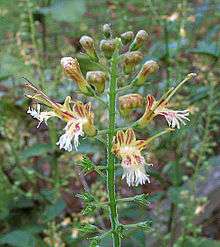Collinsonia canadensis
| Collinsonia canadensis | |
|---|---|
 | |
| Collinsonia canadensis flowers | |
| Scientific classification | |
| Kingdom: | Plantae |
| (unranked): | Angiosperms |
| (unranked): | Eudicots |
| (unranked): | Asterids |
| Order: | Lamiales |
| Family: | Lamiaceae |
| Genus: | Collinsonia |
| Species: | C. canadensis |
| Binomial name | |
| Collinsonia canadensis L. | |
| Synonyms | |
|
Collinsonia serótina | |
Collinsonia canadensis is a perennial medicinal herb in the mint family. Common names include Canada Horsebalm, Richweed, Hardhack, Heal-All, Horseweed, Ox-Balm and Stone root. It is native to eastern North America from Quebec south to Florida and as far west as Missouri, although it is mainly found east of the Mississippi River. It is endangered in Wisconsin.
Medicinal history
The plant was discovered by Peter Collinson (1693–1768), an enthusiastic English merchant botanist, who took great interest in transporting to England and cultivating new American plants. Collinsonia was not, however, used in European or American medicine at that early date, which the Lloyd Brothers pamphlet on the herb says, "nor did it attract the attention of such authoritative observers of the regular school as the Bartons, Dunglison, Zollicoffer and Griffith, probably because it possessed no prominent, poisonous or violent quality to make it conspicuous.[1] It does have a distinct odor, described by herbalist David Winston as smelling like "Lemon Pledge."
It was not until later after observing Native American medicinal uses of the plant that the herb came into the materia medica. By the 1850s it was listed in King's American Dispensatory and in Lee's New York Plants. Lee noted that the bruised leaves had been used for many years as poultices for bruises and that the Thompsonian medicalists had referred to it in their pamphlets. One factor in the long adoption was that the elements of the plant only appeared with long extraction. Another was that the root was hard and knotty: the Lloyd Brothers pamphlet on the plant notes that it tended to break grinding machines and was difficult to extract:
- ROOT. - Collinsonia is dark-brown, nearly black, knotty, very heavy, and is covered by a mass of tough, black, wire-like fibers. The green crushed root has a slight, peculiar odor, which disappears on drying. Internally, the dried root is white, odorless, and imparts little taste, even when long chewed. The active principles are very difficult to abstract, whether the drug be finely ground or powdered, its constituents demanding an element of time for their solution, regardless of the menstruum employed. Either the green or the dried root of Collinsonia imparts a deep, red-brown color to any menstruum that finally abstracts its full qualities. This color arises from the fact that its virtues reside largely in the rootlets, the brown epidermis, and the slightly colored subjacent portions, which must not be excluded if the operator expects to produce a representative preparation.[2]
According to the 1869 Cook's Physiomedical Dispensatory:
- Description: Natural Order, Labiatae. Genus COLLINSONIA: Strong scented herbs; with large, ovate and petiolate leaves; and yellow flowers in a terminal and leafless panicled raceme. Calyx ten-striate, upper lip truncate and three-toothed, lower lip two-cleft; corolla exserted, ringent; stamens two, long exserted. C. CANADENSIS: Indigenous plants, growing in rich and moist woods and fields. Stem four-sided, three to four feet high, often very smooth, but sometimes slightly pubescent. Leaves few, thin, three to four inches .long, two to three inches broad, acuminate, coarsely serrate, abrupt or subcordate at base. Flowers in large, loose, compound racemes; corolla half an inch or more in length, yellow tinged with green, the lower lip elongated and fringed, exhaling a lemon odor. July to September.
- The root of this herb is medicinal. It is perennial, knotty, rough, very hard,. dusky brown, throwing out many slender fibers, and of a somewhat unpleasant balsamic odor when fresh. From the confusion that arises from similar common names, it is necessary to distinguish this particular hardhack from the shrub Spirea tomentosa; and also to note that Ptelia trifoliata and Scrophularia marylandica are frequently called heal-all.[3]
Medicinal uses
Petersen's Materia Medica describes the use: "Has a special influence on the nervous system and mucous membranes, removing congestion and improving circulation of the capillaries. This influence is most marked in relaxed conditions of the mucous membranes of the throat and lower bowels. A valuable remedy in sore throat, laryngitis, pharyngitis, with relaxed and enfeebled capillary circulation. May be combined to advantage with other indicated remedies in atonic dyspepsia, catarrhal gastritis with defective circulation and irritable condition of the heart from weakness. In hemorrhoids, when indicated, it is our best remedy. In these cases it should be used in small doses. Scudder recommends it in nurse's sore mouth, and no doubt it is effective in such cases where there is relaxed condition with impaired capillary circulation in the parts. It is generally given in doses of 4 to 6 drops, with the exception of hemorrhoids, where 1/2 to 1 drop doses are more effective than the larger doses."[4]
Notes
- ↑ Mundy, William (ed), Scudder, Fyfe, Felter, Locke, Webster; et al. (1904). A Treatise on Collisonia canadensis. Lloyd Brothers. Scanned and republished on Web. External link in
|publisher=(help) - ↑ Mundy, William (ed), Scudder, Fyfe, Felter, Locke, Webster; et al. (1904). A Treatise on Collisonia canadensis. Lloyd Brothers. Scanned and republished on Web. External link in
|publisher=(help) - ↑ Cook, William (1869). Collinsonia canadensis in Physiomedical Dispensatory. Scanned and republished on Web.
- ↑ Petersen, J. Fred, MD. (1905). Materia Medica and Clinical Therapeutics. Scanned and republished on Web. External link in
|publisher=(help)
References
- Blanchan, Neltje (2002). Wild Flowers: An Aid to Knowledge of our Wild Flowers and their Insect Visitors. Project Gutenberg Literary Archive Foundation.
External links
- A listing of linked classic and eclectic herbals containing information on this plant at Henriette's Herbal